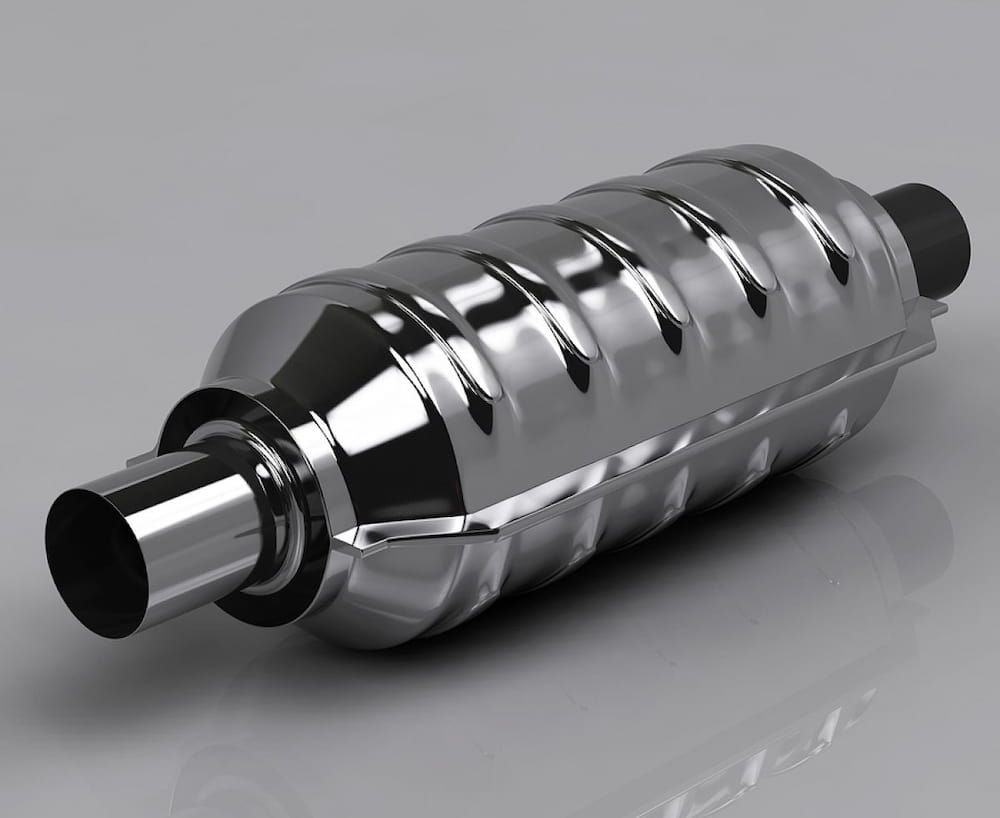
Your car’s catalytic converter removes dangerous substances from exhaust gases. It might need to be removed or replaced if it breaks down or gets blocked occasionally. Can you drive without a catalytic converter then?
You can drive without a catalytic converter generally speaking. There is no engine or vehicle damage associated with driving without a catalytic converter. However, driving without a catalytic converter may be against the law in your state, and it’s likely that your car will fail an emissions test.
For a good reason—to help reduce air pollution—the catalytic converter is a component of the exhaust system of the car. So even though you can drive your car without one, it’s generally not a good idea.
For more information, keep reading.
Table of Contents
Can You Drive Without A Catalytic Converter?
Generally speaking, you can drive without a catalytic converter. Is driving without a catalytic converter against the law? is the following query you should ask yourself.’ Are catalytic converters required for vehicles where you live? If you don’t have one, you’ll most likely fail an emissions test.
The catalytic converter works to lessen air pollution as a component of an automobile’s exhaust system. Driving without a catalytic converter won’t in any way harm your engine or your vehicle. Even if it works, it’s not always a good idea to drive without one.
Driving Without A Catalytic Converter: What Happens?
Driving without a catalytic converter comes with a number of drawbacks. While others involve the law, some are merely annoyances.
Check Engine Light Appears
The check engine light will come on if the computer in your car notices an issue with the oxygen sensors or catalytic converter. You’ll immediately understand why the light is on if you intentionally removed the converter. Due to the fact that your light will already be on, you won’t be able to detect if there is a subsequent engine problem.
Causes Pollution To The Environment
The environment suffers greatly when a converter is removed. It contaminates the groundwater and air around you, the latter of which is very important if you live in a neighborhood where people use well water.
It Is Illegal
It probably won’t be worth the hassle to remove your converter because of the legal problems that will arise. If you choose to challenge the charge, there will be fines, court costs, and attorney fees. You’ll be subject to a $10,000 fine as well as the cost of a new converter.
Costly Repair
By no means is a catalytic converter repair inexpensive. In fact, you might have to spend more than $3,000 to replace it. The cost of a converter may easily exceed the value of your car if it is an older model.
You’ll Fail To Emissions
The majority of states demand an emissions test each time your car is up for an inspection. If your car doesn’t pass inspection, you’ll need to fix the issue before it does. Additionally, in addition to potential converter fines and repair costs, you might get traffic tickets if you decide not to replace your converter and your inspection expires.
Is A Catalytic Converter Necessary For A Car To Operate?
In most cases, it is not a problem to drive without a catalytic converter. There are plenty of reasons to drive without a catalytic converter, even if you only need to for a short period of time. Catalytic converters are frequently built to last the lifetime of a vehicle.
Here is the question, can you lease a used car?
Do All Automobiles Have Catalytic Converters?
Catalytic converters frequently contain platinum, palladium, and rhodium. Hydrocarbons and carbon monoxide are then oxidized and removed by these metals. When melted down, some of the precious metals found in catalytic converters can be worth a lot of money to thieves. Theft of a catalytic converter from a car parked in a driveway is common among these thieves. If your car has been stolen, you must get a new catalytic converter or a section of exhaust pipe before you can start it again.
Is It Legal To Drive With A Faulty Catalytic Converter?
Technically, yes, because older vehicles functioned just fine before catalytic converters spread widely in the 1970s. In other words, if you’re wondering if your car will still start without one, it most definitely will. But you also need to consider whether you should take a chance.
The first thing you should be aware of is that it is prohibited to tamper in any way with the catalytic converter. This component cannot be disabled or removed, and doing so could result in fines of several thousand dollars. This is especially true in states like California, where laws governing vehicle emissions are quite strict.
The OBD 2 catalyst efficiency monitor on a modern car (newer than 1996) will cause the check engine light to come on if the light-off catalyst (the one closest to the engine) is removed. Behind the light-off catalyst is an oxygen (O2) sensor that gauges the converter’s ability to store oxygen. Four-cylinder engines will only have one of these light-off converters, while six- and eight-cylinder engines will have two (one for each bank). The exhaust stream directly behind each light-off catalyst is being monitored by an O2 sensor. Parts stores refer to this O2 sensor as a “downstream O2 sensor.”
The check engine light (MIL) won’t turn on if the rear catalyst is removed because it isn’t monitored for O2 storage. However, the vehicle will always fail emissions testing if that catalyst is removed. Since a single catalyst cannot handle all three, NOx emissions are handled by the front catalyst, and CO and HC emissions are handled by the rear catalyst.
Therefore, if you take out either the front or rear catalytic converters in a state or city where emissions testing is required, your car won’t pass the emissions test. As a result, you won’t be able to renew your registration until the emissions system of the car has been fixed to OEM standards.
What if the converter is still present but isn’t operating correctly? Of course, that will result in your car failing the emissions test. A diagnostic trouble code will be saved if the catalyst monitor function of the powertrain control module determines that a monitored converter’s O2 storage capacity has degraded.
This will also be true if the converter is clogged because the honeycomb brick has broken up or gotten seriously damaged by external impact. Your car may display symptoms such as a no-start, an excruciatingly sluggish engine, a slight loss of power, and a noticeable loss in fuel economy.
A catalyst that has failed and has an impact on how the car performs typically degrades gradually enough that it may not be immediately apparent. Some drivers will keep going despite a slight loss of power or even an illuminated check engine light. They do this until the problem gets worse. The important thing to remember is that you can keep driving without worrying about your car breaking down if the converter is simply losing efficiency. However, you’ll eventually need repairs if you live in a state where emissions testing is required.

How Long Can You Drive Without A Catalytic Converter?
Catalytic converters are not necessary to operate a vehicle. Although it is illegal to remove a catalytic converter in every state, even those that don’t enforce emissions regulations, there are cars in non-emission testing areas with catalytic converters that have been removed. Knowing that purposefully disabling a vehicle’s emission system is regarded as a serious offense will help you decide whether to remove the converter yourself (a reputable shop won’t typically do this for you). And the government has the legal right to fine you thousands of dollars for doing it.
If your catalytic converter has been stolen, you’ll notice as soon as you start your car. The loud, booming idle is a dead giveaway that your catalytic converter has been sawed off. Although we advise installing a catalytic converter protection shield in advance, you might be able to file an insurance claim to have the exhaust system repaired. Protecting your vehicle with an easy-to-install shield, such as one from Cat Security, can help you avoid theft altogether and save you thousands.
Is It Safe To Drive With A Faulty Catalytic Converter?
To answer the question, let’s begin by saying that a missing converter and a failed converter are two different things. It is safe to drive if the car will function properly enough to get you from point A to point B. However, catalytic converter failures are not always the same.
Safety won’t be a concern if the converter has malfunctioned or is missing. Nevertheless, as soon as you become aware of the malfunction or theft, you should replace the converter. Additionally, unless you intend to repair the exhaust to make it legal once more, never purchase a vehicle that has had its converter removed. After all, “safe” is a relative word. Even if you are safe physically, you may not be safe legally.
Furthermore, it might not be a good idea to keep driving if your catalytic converter is clogged or internally breaking down to the point where it is depriving your car of power. Driving a car that doesn’t function properly can result in serious traffic accidents when doing so in dense, fast traffic (such as on a congested interstate close to a major city).
Also keep in mind that even if you don’t notice or smell anything coming from the exhaust, a bad converter will result in higher tailpipe emissions. It’s not eco-friendly to do this. Additionally, people can pass away in enclosed spaces from carbon monoxide, one of the three gases the converter deals with. When there are exhaust leaks and people are inside the car for a long time while it is idling, the risk is at its highest.
And again, if the converter has mechanically failed to the point that it restricts exhaust flow, it will cause engine performance problems. However, other components of your car won’t typically sustain any damage. A notable exception to the “no usual damage” statement above would be a converter that gets extremely hot (like RED HOT (which can and does occur). A few times, parked cars have started fires in the dry grass. Keep in mind that some of the fuel lines and the majority of modern automobile fuel tanks are made of plastic. Aside from the danger to anyone inside or nearby as well as other vehicles, that fire under the car situation is deadly and has the potential to catch fire throughout the entire vehicle.
Symptoms Of A Bad Or Failing Catalytic Converter
There are indicators that the catalytic converter in your car has failed or is about to fail. They include:
- Illuminated check engine light
- Lack of acceleration
- Stalling
- Hard starting or a vehicle that won’t start at all
The check engine light will typically be the only indicator of a failed converter. However, problems like poor acceleration, stalling, and difficult starting may happen when the converter becomes clogged or restricted.
In conclusion, driving a car with a damaged or missing catalytic converter is not only prohibited but also possibly dangerous. Try to keep your trips brief and limit your driving to nearby locations if you have to use your car until you can afford a replacement cat-con.
What Purpose Serves A Catalytic Converter?
In 1975, the US Environmental Protection Agency imposed stricter standards for auto emissions control. Automobile producers began including catalytic converters in their vehicles’ exhaust systems as a means of reducing emissions in response to these regulations.
In essence, your catalytic converter works diligently to reduce pollutants in your exhaust, benefiting the environment.
Your engine burns fuel and oil, releasing poisonous fumes into the atmosphere and damaging the environment. A catalytic converter is an emission-control tool that takes those pollutants and transforms them into less harmful fumes.
A catalytic converter can be of two different types. The unburned hydrocarbons and carbon monoxide in two-way converters are transformed into carbon dioxide and water by the addition of oxygen. Additionally, the nitrogen oxide emission is decreased by three-way converters, which have largely replaced two-ways.
In The Us, Is It Against The Law To Drive Without A Catalytic Converter?
Even if your state doesn’t test for emissions during an inspection, removing the catalytic converter from your car is against the law in every state. Your emissions system must be fully functional in order to be driven, so taking out the catalytic converter is equivalent to turning it off. $10,000 in fines may be imposed if you are found operating a vehicle without a catalytic converter.
The only exception to this rule is if your car was manufactured before the Clean Air Act. You won’t be fined if your classic car lacks a catalytic converter because they weren’t standard equipment on older vehicles.
Why Is It Illegal To Drive A Car Without A Catalytic Converter?
It is illegal to operate a vehicle without a catalytic converter for four main reasons, all of which have to do with how your car will impact the environment and other road users.
You’re Disabling The Emissions System
To be considered road legal, your car’s emissions system must adhere to strict regulations. These requirements make sure that no hazardous chemicals are released into the air by your car.
You’re Polluting The Air
Most of the smoke released by your car’s exhaust system is carried by the wind. People and animals nearby who must breathe in those pollutants may suffer negative effects. Acid rain is also primarily caused by air pollution.
You’re Polluting The Groundwater
Acid rain is produced when airborne condensation and the pollution from your car combine to rise into the atmosphere. This rain seeps into the ground and taints the water when it returns to the surface.
You Could Violate A Noise Ordinance
Between the exhaust manifold and the muffler, your catalytic converter—which is a component of your exhaust system—can be found. It is a component of your exhaust system, so removing it could make your car run much louder than it otherwise would. You might be breaking a noise ordinance depending on where you live because of the increased volume.
Related Questions
What Is The Need For A Catalytic Converter?
The engine and exhaust must be built or modified to function without a catalytic converter for a vehicle to function properly. In order to increase exhaust emissions and fuel efficiency, manufacturers started using catalytic converters widely in the late 1970s and since then have developed engines that use them.
In most cases, it is no longer possible to simply remove the catalytic converter from a car without making other changes. Therefore, if your catalytic converter was stolen or if you just want to remove it for fun, it will cause some issues because they are a necessary component of the majority of modern vehicles.
Additionally, catalytic converters play a crucial role in how automakers reduce exhaust emissions. The catalytic converter is a crucial piece of machinery when it comes to reducing global vehicle emissions from an environmental standpoint.
Damage To The Engine Resulting From Catalytic Converter Removal?
No, the engine won’t be harmed by removing the catalytic converter. The catalytic converter’s job is to purify the engine’s exhaust fumes.
Simply removing the catalytic converter will cause the majority of contemporary vehicles to malfunction. As mentioned above, without a cat fitted, the oxygen sensors installed before and after the cat will not be able to function within range. Engine performance will suffer as a result of this setting off engine error codes. Therefore, even though the engine won’t be harmed by removing the catalytic converter, you should prepare for a loss of engine power and a reduction in fuel efficiency.
How Long Do I Have Before I Need To Replace The Catalytic Converter?
With a catalytic converter that is only partially blocked, you can typically keep going for thousands of miles. An error code produced by the post-cat oxygen sensor is typically the first indication of a damaged catalytic converter. The oxygen sensor will detect this if the cat is not properly filtering the exhaust fumes. Usually, there is a problem with the cat if the sensor itself is not broken.
As long as the engine is operating properly, catalytic converters should remain effective for the entire lifespan of your car. The majority of the time, they will only malfunction if the exhaust gases contain contaminants like coolant or engine oil. The internal honeycomb mesh of the catalytic converter can suffer if there is any liquid present in the exhaust gas. The interior of the cat can be burned or melted by hot oil or fuel vapors in the exhaust fumes, resulting in a blocked cat.
Any error codes or loss of fluids, such as coolant or engine oil, should be looked into as they may be leaking into the exhaust manifold, which will unavoidably result in an early catalytic converter failure.
Can I Use A Straight Pipe To Replace My Catalytic Converter?
No, you can’t just swap out a catalytic converter for a straight pipe without changing anything else about the car. In the majority of countries around the world, it is also prohibited to drive a car without a catalytic converter installed.
Exhaust fumes will be overly rich in excess hydrocarbons, carbon dioxide, and carbon monoxide if the catalytic converter is replaced with a straight pipe. The ECU will detect this variation in exhaust gases and turn on the check engine light.
In order to safeguard the engine and the environment, some modern vehicle engines won’t run properly if there are exhaust emission error codes. To get rid of the error codes and restore the engine to normal after replacing the catalytic converter permanently with a straight pipe, you will need to update the ECU software.
The Bottom Line
The catalytic converter is a crucial component of your exhaust that helps keep your car on the road and reduces air pollution. Although it’s simple to drive a car without one, it’s not a good idea to do so because you’ll endanger the environment and break the law. Consider the repercussions before removing your converter if you’ve been thinking about doing so.
I appreciate your reading.


